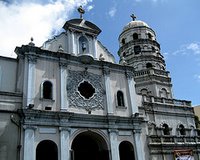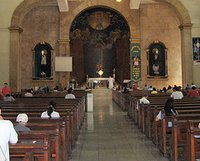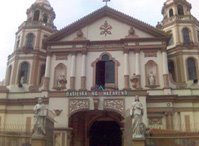Thank God the semester was finally over! The previous semester was tough with all the demands of philosophical studies. So I decided to unwind for sometime and give my self a break. For the past week I visited two Churches which are considered "pillars" of Catholicism in Manila, if you may. The Santa Cruz Church in Sta. Cruz, Manila and the Basilika ng Nazareno in Quiapo, Manila. This was a different kind of relaxation I must admit but I enjoyed it nonetheless!
It is interesting to note that these two old churches were at one point in its history were under the hands of the Jesuits. Sta. Cruz church was established by the Jesuits in the 1600's primarily to cater to the spiritual needs of the Chinese merchants and residents in the area.

The Facade of Sta. Cruz Church
But time came for the Jesuits to say goodbye to this wonderful ministry. Even before the Society of Jesus was officially suppressed as a religious order by Pope Clement XIV in 1773, the Spanish Crown decreed that the Jesuits be expelled from Spain and from all their colonies. Hence, the Jesuit exodus happened between 1767 - 1769. The administration of the Church was then entrusted to the Archbishop of Manila.

The interior of Sta. Cruz Church
It was in the 1950's (I think) that the then Archbishop of Manila, Rufino Cardinal Santos, invited the Congregation of the Blesed Sacrament to administer the Parish. The Sacramentinos came to the Philippines in 1956. This year marks the 150th anniversary of Sacramentino presence in the Philippines. The present Sta. Cruz Church has been proposed to become the National Shrine of the Blessed Sacrament. Adoration of the Blessed Sacrament exposed on the altar happens the whole day.
The Basilika ng Nazareno or commonly known as the Quiapo Church was established in 1606. The Church now celebrates its 400th year of foundation. There came a point (can't remember if it was in the 1600's or 1700's) that the Governor General entrusted the administration of the Church to the Jesuit Fathers. The Jesuits took care of the church for four years.

The facade of the
Basilika ng Nazareno
Quiapo Church has been the center of the devotion to
Señor Nazareno or Jesus of Nazareth on His way to Calvary. The Basilica receives millions of devotees and pilgrims each year. In fact, all the Masses at the Basilica on Fridays are jam-packed! A sign of deep Filipino religiousity and devotion. The Basilica is now being administered by the Diocesan Clergy of the Archdiocese of Manila.
Unfortunately, when the Society of Jesus was restored as a religious Order in the Church in 1814 by Pope Pius VII, all our properties were never returned to us. In fact, the condition made by the Queen of Spain to the Jesuits when they came back to the Philippines in the 1800's was for the Society not to claim back their properties and churches. We started from scratch and focused on the missionary works in Mindanao and in the administration of the
Ateneo Municipal de Manila, now the Ateneo de Manila University. We do not have old churches under our pastoral care.
But it is consoling to note that the Jesuits (the religious Order that I belong to) has a share in the course of history of these two significant Churches. And as a young Jesuit, it is my consolation to visit these churches and participated in the Eucharist celebrated in these churches, my simple link to the richness of the tradition and devotion nurtured and harnessed in these churches. My visit was my simple connection to my brother Jesuits who worked in these churches. My tribute and respect to the countless Jesuit Fathers and Brothers who labored in the administration and care of both the Church and the parishioners.
+ + + Ad Majorem Dei Gloriam + + +




0 Comments:
Post a Comment
<< Home